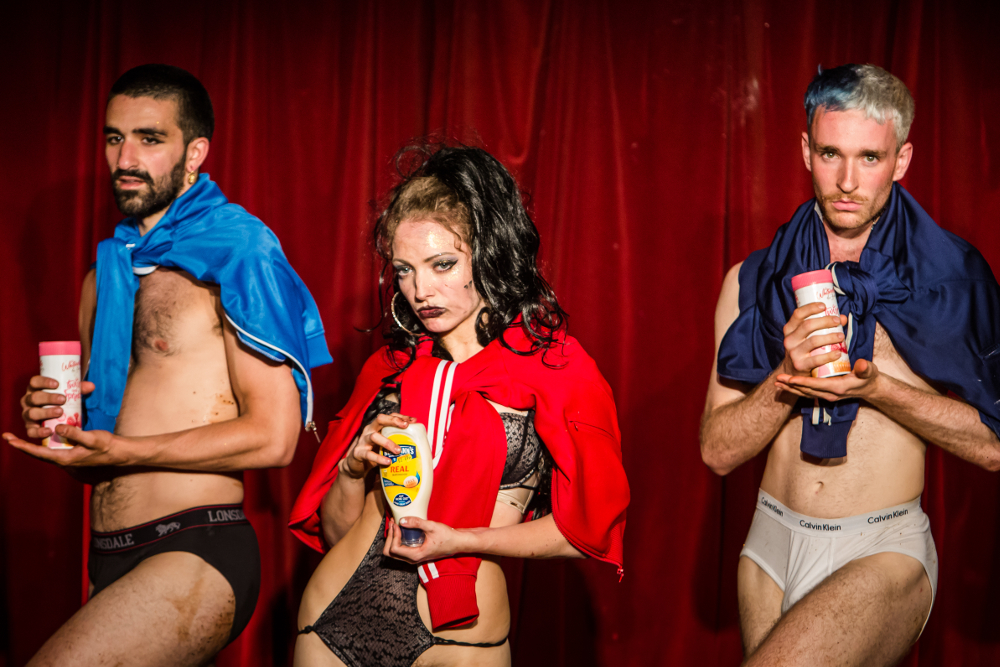
Photo courtesy of Soho Theatre. Catch Triple Threat at the Schaubühne, Wilmersdorf, on Mar 13, and 14, 21:45, in English.
Lucy McCormick blends stand-up, performance art, music and dance to deliver blistering mixed-genre shows that have thrust her from a cult following on Britain’s queer club circuit to mainstream acclaim at the Edinburgh Fringe Festival and beyond. Born in 1986, McCormick studied drama before finding her feet in the world of performance art and queer cabaret. Since then, she has performed at London’s Southwark Playhouse, Soho Theatre and Gate Theatre. This month, the Schaubühne has invited her 2016 show Triple Threat to its annual FIND Festival, directed by cabaret legend Ursula Martinez – an X-rated re-enactment of the New Testament, accompanied by her backing dancers, Girl Squad.
The name of your performance is Triple Threat. Where does the title come from?
It stands for a few different things. The phrase triple threat comes from musical theatre and describes a performer who can sing, dance and act – and we use all three mediums in the show. There are also three of us on stage. And the number is a recurring theme in the show because it’s a re-enactment of the New Testament, so it also refers to the Father, the Son and the Holy Spirit.
The New Testament seems like an unlikely source of inspiration for a queer performer. What do these old Bible stories mean to you?
The show is a feminist, queer re-telling of the New Testament. It’s about trying to understand these stories in the present, about attempting to transpose them onto my body to see how they make sense. But pop culture and imagery also play an important role. In a way, they have been my own form of religion. I developed the show through club performances and cabaret and so I was also looking at the nightclub as a church.
Speaking of transposing these stories “onto your body”: there’s a lot of nudity in Triple Threat. Is that not somewhat blasphemous?
The New Testament is a very bodily story anyway. But it’s also a patriarchal, male narrative. I felt that using my naked body in the performance provided strong imagery, a counter-narrative. But coming back to these pop-cultural references: my naked body is a way of me reappropriating that imagery by finding agency within it.
The show also has some sexually explicit scenes. How have audiences reacted to these?
A key question with this project was how we can use performance art and some of its tropes without scaring people off. How can they make sense within this story? How can they not feel like taboos? What’s been so satisfying, and maybe a little bit surprising, is that this balance has worked. If you read what happens on paper, these scenes might sound shocking, but this isn’t a show that people generally walk out of. I suppose there might be an element of shock to some of these scenes but on the whole, people really get it.
You come from the queer club scene. What influence has performing in this environment had on your work as a performance artist in theatres?
I think it has inspired me to be very visual with my work, because you can’t get away with having loads of text in clubs. It also helped me to be quite economical and get straight to the point. It wasn’t easy making something that started out as a club piece into a theatre show. It still has those club influences – like the loud, beat-driven music, sections of dance and sweaty bodies. I want the show to feel like a party. What I love about club contexts is that it really feels like the audience owns the night. You really have to go out and win them over – and that’s great training. It’s a good place to test out your ideas because you better get the crowd on board or they’ll turn around and torture each other.
The performance is directed by Cabaret legend Ursula Martinez. How did you get her on board for the project?
I’d met her a couple of times and she had seen some of my work, so I immediately asked her when I decided to work on a show for the first time under my own name. It’s a great collaboration. My ideas tend to be quite conceptual and image-based, whereas she’s very good with text and also as a cabaret-performance art crossover artist. And she’s very blunt. That’s a very good quality in a director.
Triple Threat | Schaubühne, Wilmersdorf. Mar 13, 14, 21:45, in English.


